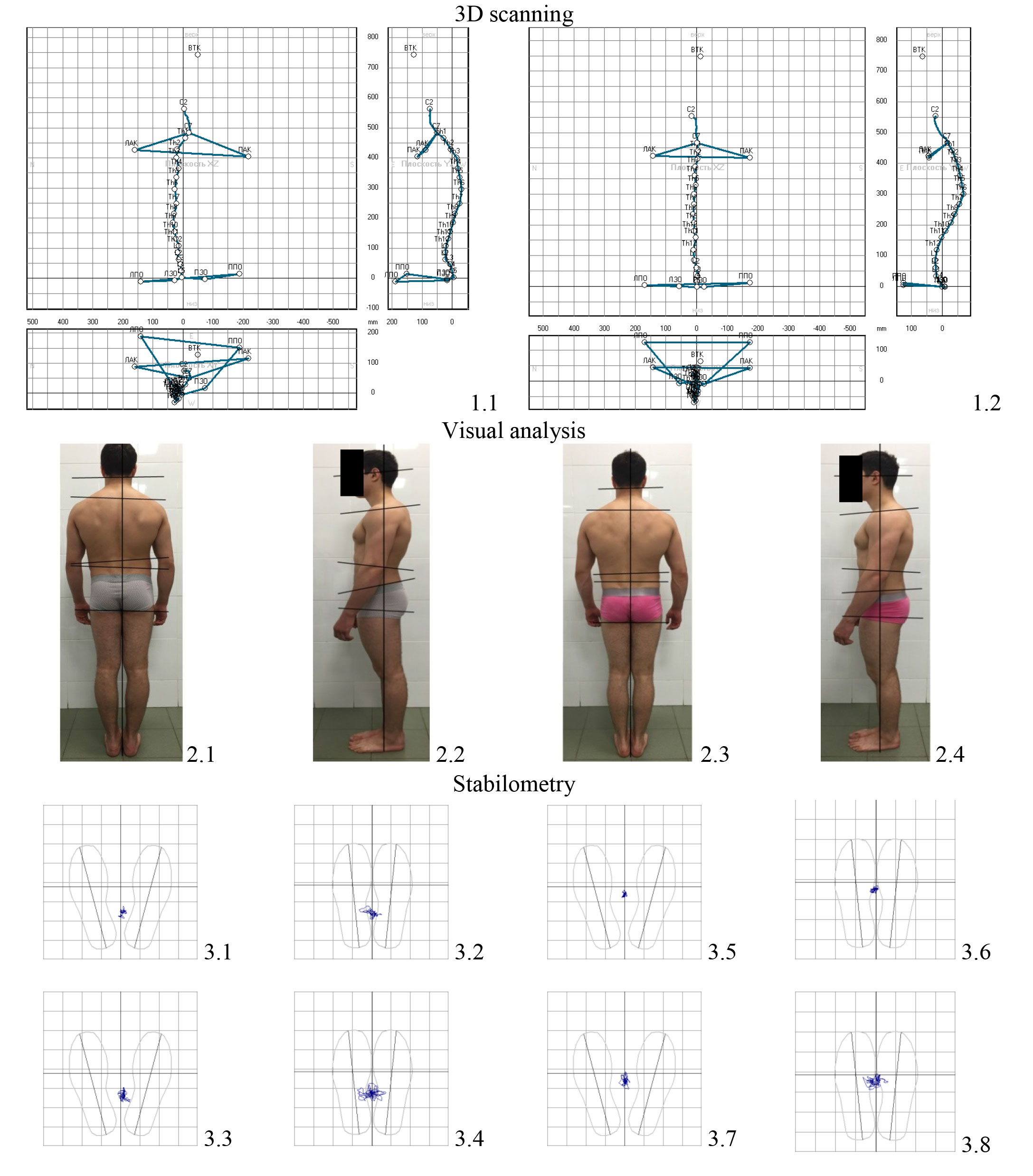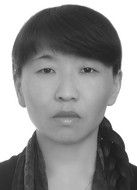Rating benefits of musculoskeletal system disorders prevention and correction method based on motor profiles in judo
Фотографии:
ˑ:
Dr.Hab., Associate Professor T.K. Kim1
Applicant A.A. Podlesnykh1
1Moscow State Pedagogical University, Moscow
Keywords: motor profile, method, correction, stabilometry, 3D scanning, junior athletes, judo.
Introduction. It is generally admitted that the results of combat athletes’ sports performance in high-level competitions depend on the organization and content of the educational and training process, including all types of training, extra-training and off-season factors that supplement and optimize the athletes’ training and competitive activities at all stages of the long-term training [4, 6].
Of particular concern for many authors is preservation of combat athletes’ sport career longevity, providing for their successful performance and high achievements in international competitions over a period of several Olympic cycles. However, it is sports-related injuries that are considered by experts as the most common reason for promising young athletes to retire early from sports. Numerous publications highlighting similar problems state that unreasonable selection of exercises, inadequate asymmetric loading in the period of intensive juvenile growth and development lead to a variety of musculoskeletal system (MSS) disorders, including postural disorders, dystonic muscle activity, internal organs and body systems dysfunction [1, 2, 4-6].
The pedagogical observations of the direction and content of athletic training of representatives of various types of combat sports conducted throughout 2012-2017 in different regions of the Russian Federation, conversations with doctors in sports medicine, and analysis of the athletes' medical records reveal that a one-way method of teaching of motor actions and developing physical qualities (prevailing in the work of most of trainers) aggravates asymmetry on the part of the MSS and, as a result, prevents the athletes from full realization of their potential during training and competitive activities, achievement of the maximum sports result.
Despite the fact that ontogenetic asymmetry in the structure and functions of the body is entirely socially constructed, it is formed as a biological feature of the body. This suggests the possibility of predicting motor asymmetry, but at the same time makes it possible to individualize the process of long-term training of sports reserve and elite athletes.
Objective of the study was to scientifically substantiate the methods of prevention and correction of structural and functional changes in the musculoskeletal system of judokas based on their motor profiles.
Methods and structure of the study. The study was conducted from November 2016 through April 2017 and involved 32 judokas of 13-15 years of age, trainees of the Sports and Education Center "Sambo-70" and Specialized Children and Youth Sports School of the Olympic Reserve specializing in judo named after S.Kh. Nirov (Nalchik), with different sports experience (from 5.5 to 7 years). The study of the junior judokas’ MSS revealed various postural disorders, muscular imbalance on the left and right sides of the body. According to the experiment, the detected deviations are highly correlated with the athlete's motor profile (r=0.71) and are a result of the right- or left-sided motor asymmetry. In this regard, as part of the pilot study, we developed the musculoskeletal system disorders prevention and correction technique for junior judokas based on their lateral psychophysiological profile, including a set of measures and a list of special corrective exercises helping to level out the existing or emerging changes in the athletes’ musculoskeletal system and posture. The experimental technique was used in the process of the training sessions and self-tuition [3, 5]. The benefits of the training sessions were assessed based on the offered method and included: visual analysis; anthropo- and morphometric study; muscular functionality tests; instrumental methods (3D scanning and stabilometry).
Results and discussion. The test data processing and analysis revealed 5 types of psychophysiological organization and the nature of the MSS disorders and dystonic muscle activity in athletes. Let us consider the findings by the example of evaluation of the studied parameters in athlete Alexander M., 15 years old, having 7 years of sports experience.

Figure 1. The comparative analysis of the individual parameters of the judoka’s musculoskeletal system (A.M., 15 years old) using the instrumental methods (3D scanning, stabilometry) and visual analysis prior to the experimental technique (November, 2016 - 1.1, 2.1, 2.2, 3.1, 3.2, 3.3, 3.4) and after the pilot testing (March, 2017 - 1.2, 2.3, 2.4, 3.5, 3.6, 3.7, 3.8)
Muscular functionality tests help find which weakened muscles in the junior athletes’ body are involved in stabilizing the cervical, thoracic and lumbar regions. There was a significant difference between the right and left sides of the body with respect to these muscles, which was manifested in reduced response time during stretching and indicated muscular hyperirribability.
3D scanning helped diagnose the MSS disorders. Thus, the diagrams and digital parameters obtained within the subject’s coordinate system made it possible to make an accurate data correlation before and after the application of the experimental method (see Figures 1.1-1.2). In Figure, a group of parameters characterizing arch rate, curvature, disorders in different regions of the spine, angles of their position relative to pelvic and shoulder girdles, relative position of pelvic and shoulder girdles in space in each plane, registered in March, 2017, approached the optimal position of the athlete’s body and its links in space.In this view, the corrective resource was committed to the muscles involved in stabilizing the mentioned region of the spine. The work with the athlete involved activities held using the developed complex method of correction and elimination of pathobiomechanical manifestations (see Figures 1.2-2.2). At the same time, it should be noted that the method of correction of the identified disorders and their prevention was developed individually for each athlete, taking into account the current status of their MSS, muscular imbalance and peculiarities of their psychophysiological organization. A set of corrective exercises to restore the optimum statics was used by the athlete on the mats prior to the main part of the training sessions, in a gym and during homework.
It is well known that sports activity is largely determined by the individual’s ability to maintain certain positions efficiently and effectively, when required, appropriately to the situation, and change them. The ability to maintain static and dynamic equilibrium determines the effectiveness of sports activity. The athlete’s ability to coordinate his vertical position estimated using stabilometry ("Stabilograph ST 150") made it possible to study the junior judokas’ functional state, detect various MSS disorders, monitor the effects of special corrective exercises on the muscular system activity and condition of the spine [2]. The follow-up control and diagnostic measures revealed a positive dynamics of changes in statics and its fixation at the proper level in the examined athlete (see Figures 2.3-2.4). The positive impact of the muscular imbalance correction method was evidenced by the dynamics of individual parameters characterizing the athlete’s orthograde pose coordination - the functional stability indices (1.64 c.u.) and Romberg’scoefficient (112.7%).
As seen from Figure, in November, 2016, the examined athlete had high values of the common center of pressure (CCP) area, more pronounced in the sagittal plane. The judoka’s CCP was in the rear position both in terms of visual monitoring and without it. Besides, when dropping the observations, the role of the current muscle tone in the formation of the orthograde pose of the athlete is reduced (see Figures 3.1-3.4). At the same time, the analysis of the data obtained in March, 2017, clearly demonstrates that the targeted impact on the athlete’s weak muscle groups results in the restoration of stability of maintenance of the vertical posture in terms of the parameters under study, as evidenced, among other things, by a significant reduction in the area and a shift towards the central position of the CCP, both in terms of visual monitoring and without one (see Figures 3.5-3.8).
Conclusion. Stabilometric tests, 3D scanning, muscular functionality tests and visual analysis are informative methods to determine the specificity of impact of a long-term, accented intense muscular activity on the mechanisms of formation of athlete’s motor stereotype and associated motor profile. Detection at the early training stages of undesirable morpho-functional disorders in the MSS in junior judokas and prompt preventive measures to negate their negative effects would help restore the corrective resource of a particular athlete and, thus, optimize training and competitive activities.
References
- Berdichevskaya E.M. Funktsionalnaya mezhpolusharnaya asimmetriya i sport [Functional interhemispheric asymmetry and sport]. Funktsionalnaya mezhpolusharnaya asimmetriya. Khrestomatiya [Functional interhemispheric asymmetry. Reader]. Moscow: Nauchny mir publ., 2004, pp. 636-671.
- Ivanov V.V. Osobennosti podderzhaniya vertikalnoy pozy v usloviyakh vozdeystviya nekotorykh faktorov vneshney sredy (na primere sportsmenov vysokoy kvalifikatsii s razlichnoy spetsializatsiey i patsientov s narusheniem oporno-dvigatelnogo apparata). Avtoref. dis. kand. med. nauk [Peculiarities of maintaining vertical posture under certain environmental factors (case study of skilled athletes with different specializations and patients with musculoskeletal disorders). PhD diss. abstract]. Moscow, 2009, 24 p.
- Kim T.K., Podlesnykh A.A. Opredelyayuschie cherty metodiki korrektsii myshechnogo disbalansa u yunykh dzyudoistov v protsesse uchebno-trenirovochnoy deyatelnosti i vnetrenirovochny period [Formal characteristics of muscular imbalance correction technique in junior judokas in education and training process and in off-season period]. Uchenye zapiski un-ta im. P.F. Lesgafta, 2016, no. 2 (132), pp. 92-99.
- Lebedev V.M. Teoreticheskoe i prikladnoe znachenie fenomena asimmetrii v sporte [Theoretical and applied importance of asymmetry phenomenon in sports]. Teoriya i praktika fiz. kultury, 1975, no. 4, pp. 28-31.
- Podlesnykh A.A., Kim T.K. Osobennosti proyavleniya myshechnogo disbalansa u dzyudoistov s razlichnym psikhofizicheskim profilem [Specific manifestations of muscular imbalance in judokas with different psychophysical patterns]. Uchenye zapiski un-ta im. P.F. Lesgafta, 2015, no. 12 (130), pp. 160-165.
- Chermit K.D. Simmetriya-asimmetriya v sporte [Symmetry-asymmetry in sports]. Moscow: Fizicheskaya kultura i sport publ., 1992, 256 p.
Corresponding author: kim.tatiana@mail.ru
Abstract
The intensive growth of competitive martial arts the world over associated with the growing competitiveness at different levels force sport communities to develop new training methods to improve the quality of the sport human resource, secure high competitive longevity and prevent injuries. The article analyses findings of the experimental study to rate benefits of a new muscular imbalances correction method applied in junior judokas’ training system based on analyses of the test data including stabilometric data (balancing function rating data), 3D scans, and muscular functionality tests. The test rates were applied as markers of the junior judokas’ overall and special fitness and their musculoskeletal system functionality. The study data and analyses demonstrated benefits of the motor profiles for tracking the judoka’s motor stereotype formation process including the morpho-functional characteristics of the muscular system and musculoskeletal system to prevent postural disorders and improve the balancing abilities in standing positions. The findings should be taken into account in the junior judokas’ education and training process.



